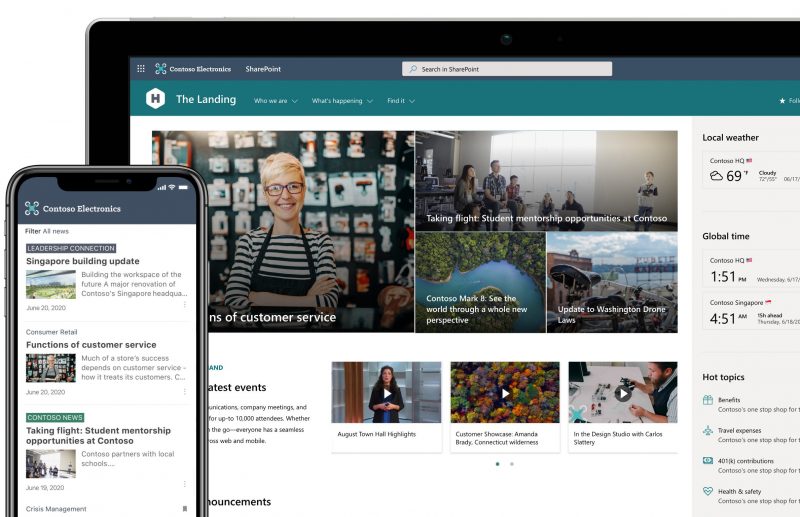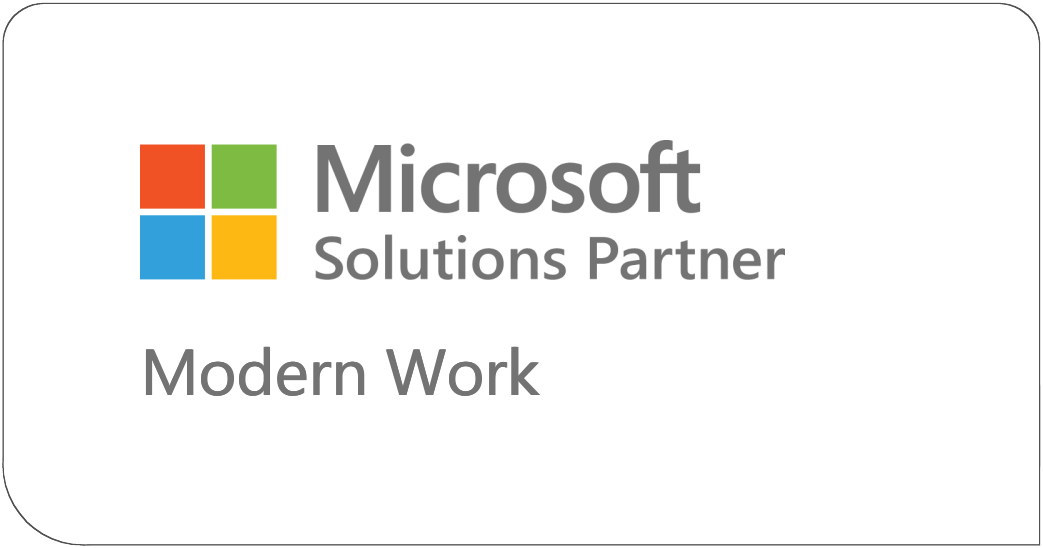Our modern workplace solution is for small to medium businesses that want to meet the demands, and challenges, of hybrid working. Using integrated cloud-powered technology to focus on the needs and structure of your organisation, unlike server-based applications and third-party services held together by disparate IT systems.
Create a cohesive, organised, collaborative digital workspace for your office-based, remote or hybrid workforce with a trusted, expert IT partner.
Get in touch today for a FREE demonstration.
Arrange a FREE demonstration today
Find out how the Microsoft Modern Workplace can transform your organisation.
Empower employees to
Achieve more while fostering greater collaboration from anywhere.
Data and collaboration
Collaborate with your colleagues in real-time using office apps. Sync and work with all your files everywhere and on any device.
Device management
Reduce the complexities of remote deployment, management, and updates with standardised and secure devices.
Cyber security and compliance
Meet insurance demands while reducing your exposure to security risks. Defend against advanced cyber threats and control access to sensitive information and secure devices.
Cost savings and added value
Introduce stable cost predictions when refreshing and upgrading devices to respond to security and compliance risks.
What is Microsoft Modern Workplace?
A Microsoft powered modern workplace is built around an organisation’s way of working. Our solution delivers a Microsoft Modern Workplace easily and effectively without major disruption or downtime.
A modern workplace solution is an effective way for an organisation to create a cohesive, organised, collaborative workspace for an office-based, remote or hybrid workforces. It creates an IT ecosystem that can grow with the increasing technology demands placed on a business, no matter what the size.

A Modern Workplace incorporates communication solutions and collaboration tools
Here are a few we offer
Meet remote and hybrid working challenges with leading Microsoft technology.
As a Microsoft Modern Work Solution Partner, we have the expertise, knowledge, and a range of technology to create, deploy and manage your organisation’s modern workplace solution.

Familiar, easy-to-use
Word, Outlook, Excel, and PowerPoint are amongst the work-ready applications most UK companies rely upon.
Increase the flow of work
Microsoft applications are designed to work with each other and have embedded them into platforms such as Teams – which work over desktop, mobile and the web.
Time efficient ways
Easily deploy devices and give access to approved applications. New devices can be up and running and ready for users in under 30mins.
Increased IT efficiency
Defend against threats, mitigate compliance and privacy risks, protect, and govern sensitive data, and secure cloud environments. Access controls let in only the authorised users, protecting your data, and proactively blocking threats.
What are the benefits of implementing a modern workplace solution?
The cost of a Modern Workplace solution is more affordable than you think.
Select a licence based on user profiles, talk with our consultants to map a workplace that meets your organisational needs, then together we implement a modern workplace solution supported by our helpdesk.
We ensure that your Microsoft Modern Workplace leverages the licences you already have and match the exact requirements of your users and the features environment their role requires.
Microsoft licences
Our licensing experts work with you to identify the most suitable licenses based on the features and role-specific attributes.
From £4.50 – £16.60
per user per month
Billing conditions apply
Build your Microsoft Modern Workplace
The costs to build a Microsoft Modern Workplace are typically half that of traditional options such as servers or a mix of cloud-based products and we offer one off or flexible monthly payment options.
From £3.50
per user per month
Billing conditions apply
Support
Enjoy reduced support costs for your modern workplace solution.
From £14.50
per user per month
Billing conditions apply
IT Champion took the time to explain our options and provide a clear demonstration…
“We knew exactly what our new system could look like, and how it would operate. Unfortunately, Covid-19 forced our planned face-to-face training prior to launch to be conducted virtually and immediately after we closed our office and introduced home working for all office-based staff. The implementation of SharePoint was very timely as it enabled our staff to access the required files whilst working from home. IT Champion were on hand to assist with any initial teething problems and have been very supportive ever since”
Our two-step process to create your Microsoft Modern Workplace.
Step one – Arrange a free demonstration
Modern Workplace is used by hundreds of thousands of businesses and millions of users throughout the world, it can be very difficult to visualise what it looks like for your organisation. Every Modern Workplace journey starts with a demonstration of what it is and what it is capable of, and this demo is completely FREE of charge.
Step two – Schedule a discovery and planning day with one of our consultants
With the demo completed and a solution identified, we move to discovery and planning. We understand how you work and your goals. During discovery, it’s recommended that key stakeholders, department heads or business unit managers are involved to ensure everyone had a clear understanding of requirements and processes. We take time to understand your short-term objectives and future goals.
Once completed, you will have a clear proposal of what your Modern Workplace can accomplish for your organisation. We break the journey into clearly identified phases.
Arrange a FREE demonstration today
Find out how the Microsoft Modern Workplace can transform your business.
A modern workplace solution drives productivity with collaboration, communication and opening access to key resources.
Forms – Collect data and make better decisions with an easy form to create polls, surveys, and quizzes.
Office – Access Word, Excel, and PowerPoint from anywhere on your favourite browser.
OneDrive – Enjoy 1TB of storage per user to access and protect your business with this intelligent files app.
Planner – Organise teamwork with intuitive, collaborative, visual task management.
SharePoint – Company intranet packed with intelligent features and available from anywhere.
Teams – Chat, Meet, Call and Collaborate in a single app with Video conferencing.

With modern workplace solutions, organisations can adapt and enhance what they can do with the power of data analytics and automated processes.
Power Apps – Rapidly building low-code apps that modernise processes and solve tough challenges.
Power Automate – Build automated processes with flows with a no-code approach that connects popular apps and services.
Power BI – Unify data to create interactive dashboards and reports.
A cloud-based phone system is essential for a modern workplace.
The ability to make calls from anywhere, on any device extends the reach of your organisation’s ability to flex and adapt.
Adding a Microsoft 365 Business Voice licence to an existing base licence, which includes Teams and a little backend magic, Teams provides you with a phone number and dialling pad, allowing you to stay connected with a single phone number across all of your devices. You can easily bring over telephone numbers from existing phone systems or choose from new local numbers or national numbers.

A modern workplace solution is secure and compliant.
Protect data and users with a secure, always-available, workspace.

A modern workplace is effective and efficient solution
Costs are a lot less and much lower than traditional solutions or a mix of other cloud-based services.
For organisations that need to be compliant with enhanced data and information governance standards, such as Cyber Essentials, ISO standards or government and local trust requirements, the Microsoft Modern Workplace makes it simple to create and manage a working environment that is both secure and compliant.
By adopting a Microsoft Modern Workplace, you can add considerable control over data, what, and how their team accesses company resources. Enabling additional security features depends on what devices are in use or from what location data is being accessed. Adding controls over what data can be downloaded or shared and adding policies to control important information is all possible.
Some fears remain about cloud-based working when data and resources are supplied and managed outside of an organisation’s direct control. The actual risk is more towards organisations that use traditional on-premise infrastructure than cloud-based services from organisations like Microsoft.
With subscription-based services, your organisation gets the latest software, automatically updated and protected. Many of the products have inbuilt backup and recovery options. These products can work from any device and any location. Traditional threats like fire, flood or loss of power or connectivity may impact working for organisations that have their infrastructure but cause little impact on cloud-based systems.


















